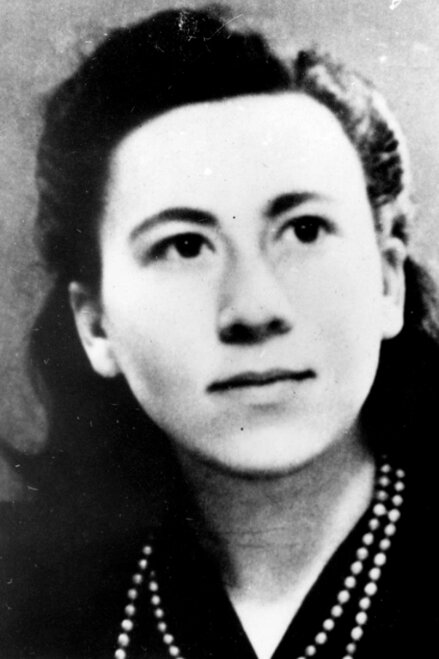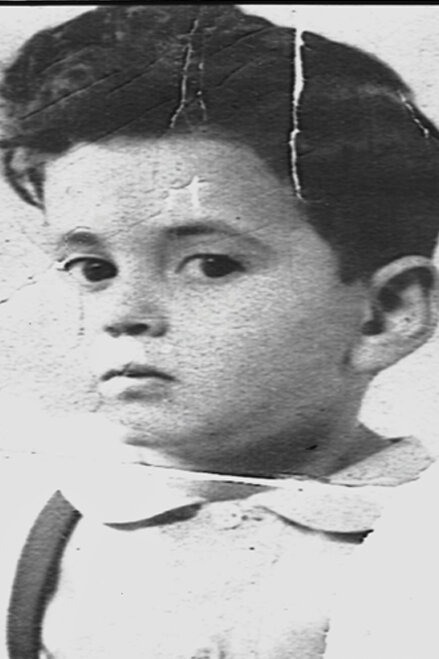Jantje Spier & Philip Pach Speyer
Although large numbers of people responded to Nazi actions in July 1942, there were already rescue groups in operation. Among the very first to respond to the cries for help were the student groups in Amsterdam and Utrecht. The original organizers evaluated the need and determined that they were going to focus on saving children. Known as the Utrecht Children’s Committee, these first members realized that hiding children in Amsterdam was futile because of the constant raids, so they developed a network of people who helped to transport, hide, foster, clothe, and feed the children in their care. Among the leaders in Utrecht was Geertuida van Lier, also called Truitje or Trui.
Truitje was the daughter ofAlfred Johan Salomon van Lier, a Jew and his non-Jewish wife, Cornelia Geertruida Guldensteeden Egeling. In 1935 Truitje started studying law. In November 1940, she founded a childcare center in Utrecht which she called Kindjeshaven or Child Harbor in English. Children who were rescued in Amsterdam were transferred to Kindjeshaven by the Utrecht student resistance. Here foster families were found by the workers of the center.
Truitje found addresses of people willing to take children. Some, afraid to take a child permanently, became “foster parents” for fifty guilders a month. Even those who took on children permanently were helped by the students’ groups, who provide forged documents and ration cards for food. Additionally, they helped with clothing and money. Together with Jet Berdenis van Berlekom, Truitje managed to bring 150 Jewish children to safety via the children's home during the occupation. She went into hiding in 1943 when her cousin Truus, also in the resistance, was arrested and executed. Jet ran Kindjeshaven until February 1945 when Holland was liberated.
“He came to us after he had been there [in a coal bin] for several nights. He was nothing but coal...”
Geertuida Van Lier
Photo Credit: Yad Vashem
Nederlands: hoek Kindjeshaven
Photo Credit: The Rijksdienst voor Cultureel Erfgoed, exclusively provides images that are either made by its own employees, or that are otherwise free of copyright.
Among the neighborhood girls working at Kindjeshaven was a 16-year-old girl named Jannie Spier. One day in mid-1942, a 2-year-old that had spent several days in a coal bin was brought to Kindjeshaven. His name was Flipje Pach (Philip) and he was transferred from Amsterdam to Utrecht by several groups of students.
Philip was born on May 30, 1940, ten days before the occupation of Amsterdam. Philip’s parents, knowing that round ups were imminent, arranged for him to be placed with non-Jewish neighbors who would hide him. Philip’s parents were subsequently deported to a transit camp and then transported to a concentration camp.
Philip with his Mother, Mina and Father, Leendert in the fall of 1941 at 1 year old
The one-inch photo was carried by his mother throughout her internment between 1943 and 1945. Philip was 2 years of age.
The neighbor who had Philip became terrified of the German searches and she hid him in a coal bin, where he stayed while the Germans searched for the house. When the Germans came, they investigated everywhere, including the coal bin, which they stabbed with their bayonets to see if anyone was hidden there.
Philip was then taken by students from Utrecht University who posed as his parents. He arrived at Kindjeshaven completely traumatized by the experience in the coal bin. He was totally covered with coal dust, both inside and outside of his body. After treatment by a doctor, Philip stayed at Kindjeshaven for several weeks. At the end of this period, Jannie Spier was asked if her mother, Jantje, would take him. Jannie eventually brought him home to her mother.
Jantje was very reluctant and refused to take him in because the penalty for harboring Jews was death. As Jannie was about to return Philip to Kindjeshaven, she told her mother the little boy was named Philip. antje upon hearing his name gave pause because her deceased husband’s name was Philip. Jannie recalled her mother saying:
“God took one Philip from me and brought another—we will take him.””
Philip Speyer, Utrecht, Holland, during World War II. Picture taken when he was hidden by his Jantje Spier and Family.
Philip (at age 3 or 4) in hiding in Utrecht. Foster sister Jopie (left) and friends.
Philip became a member of the Spier family, calling Jantje “Tante” which means aunt in Dutch. He also acquired four foster sisters: Tiny who was 18, Jannie who was 16, Ans who was 14, and Jopi who was 9. Being the youngest, Jopi spent most of her time with Philip. Jantje, realizing that she could not keep Philip in the house all the time, told Jopi to take Philip out to play. Worried about Philip’s dark complexion and hair compared to her blonde daughter’s, Jantje told people that he was half Indonesian, and his parents were stuck there because of the war. (Indonesia was a Dutch colony).
Philip became a member of the Spier family, staying with them from 1942 to 1945. I During this time, their home was threatened when Utrecht was bombed by the English, because their home was near a German ammunition and supply depot. At times, these raids occurred while Jopi and Philip were outside. When the air raid sirens sounded, Jopi threw Philip down into a bunker and covered him with her body until the all clear was sounded.
The war ended in 1945 and Holland was liberated. One night, Jopi was in the living rom and saw a woman walking towards the house with a bouquet of flowers. The woman was Philip’s mother, Mina Pach. Mina was liberated from Bergen-Belsen in April 1945. From the concentration camp she went to a Displaced Persons camp until May, returning to Amsterdam in June. There she learned that Philip survived the war with the Spier family. Mina came to Utrecht to make arrangements to take Philip back to Amsterdam. Being only two when he was separated from his mother, Philip did not know who she was and was afraid to go with her. After five more trips to Utrecht, the time came for Philip to return to Amsterdam with his mother, however, he still refused to leave his family in Utrecht. On Mina’s sixth visit to the Spiers, Jantje told Jopi to go to Amsterdam with Mina and Philip to ease him through the transition. Eventually, Mina and Philip brought Jopi back to Utrecht, and Philip went back to Amsterdam with his mother.
Jantje Spier was awarded the Memorial Cross for her bravery, courage and dedication during the war years.
Years later, Jantje Spier was awarded the Memorial Cross for her bravery, courage, and dedication during the war years.
In 1953, Mina re-married and the family emigrated to America. In 1957 Philip’s sister Regina was born. In December 1958, Philip became a citizen and enlisted in the army. After his tour of service, Philip returned to the United States, and became a stockbroker. He moved to Scottdale, Arizona in 1997.
Philip and his foster family have stayed connected and he speaks fondly of them. Philip has been to Holland to see his sisters and Jopi came to Scottsdale from Utrecht. Three years ago, Jopi died and Philip returned to Utrecht for her funeral and gave her eulogy in Dutch.
Truitje van Lier and Jet Berdenis van Berlekom were both honored as Righteous Among Nations by Yad Vashem. They were also recognized at The Hague in 1992. Truitje died in 2002 and Jet died in 2010.
Philip’s foster sisters during a reunion in the Netherlands in 2005. Pictured from the left are Jopie, Tiny, and Ans.
Unless credited with prior ownership and copyright - all displayed imagery, documents, brochures, books, materials, recordings, video, broadcasts, and promotional materials of every form and description, whether in written, analog, digital, film or electronic form, prepared by Arizona Jewish Historical Society shall remain the copyrighted property works of Arizona Jewish Historical Society. Any unauthorized use of that information or materials may violate copyright, trademark and other laws. Any rights not expressly granted are reserved.
AZJHS is deeply grateful to all our donors and sponsors for their generous support and gifts throughout the year. Because of you, we are able to continue providing to the public at no cost our many programs, events and exhibits.
You have just entered our exhibit the
We Remember: The Righteous
Each exhibit room will end with a button asking you to click to enter the next online room.
If you prefer to choose your own room and not follow the structured suggested exhibit tour, please look below for the outline “key” of links allowing you to choose the room you would like to enter.
We Remember: The Righteous Exhibit Key
(Please choose from the links below to enter the exhibit room of your choice.)
Exhibit Entrance
Schindler & White
The Quatrevilles & Adelman
Lier & Speyer
Remembering the Righteous
SPEAKER: Holocaust Survivor Phil Speyer
Featured guest, Holocaust Survivor, Philip Speyer recounts his personal story of survivor in Amsterdam, Holland. Philip was saved by Truitje and Jett, who were both recognized by Yad Vashem as Righteous Among the Nations. Philip recounts how he was able to research his past and understand how he was placed in Kid’s Haven, which ultimately saved his life.
The Perilous Journey of a Hidden Child during the Holocaust
Friday, September 17, 2021
SPEAKER: Holocaust Survivor, Philip Speyer
Featured guest, Holocaust Survivor, Philip Speyer recounts his personal story of survivor in Amsterdam, Holland. Phil was saved by Truitje and Jett, who were both recognized by Yad Vashem as Righteous Among the Nations. Phil recounts how he was able to research his past and understand how he was placed in Kid’s Haven, which ultimately saved his life. Then, later, Philip’s Foster Mother, “Tante” Jantje Spier, was awarded the Netherlands’ Resistance Memorial Cross for bravery during the war. Philip lived with Tante and her daughters from 1942 -1945, from age 2 to 5 years old.
Kindjeshaven - Trailer
(Source: You Tube, Tim Alberts









